The Acer Nitro 5 Gaming Laptop Review: Absolutely AMD - Ryzen Plus Polaris
by Brett Howse on February 15, 2019 8:30 AM ESTDisplay Analysis
Acer’s Nitro 5 offers a 1920x1080 15.6-inch display which is an IPS panel, which is great to see. Even though this is a value offering, it would have been disappointing to see a TN display, so well done Acer. That is about where the good qualities of this display end, unfortunately.
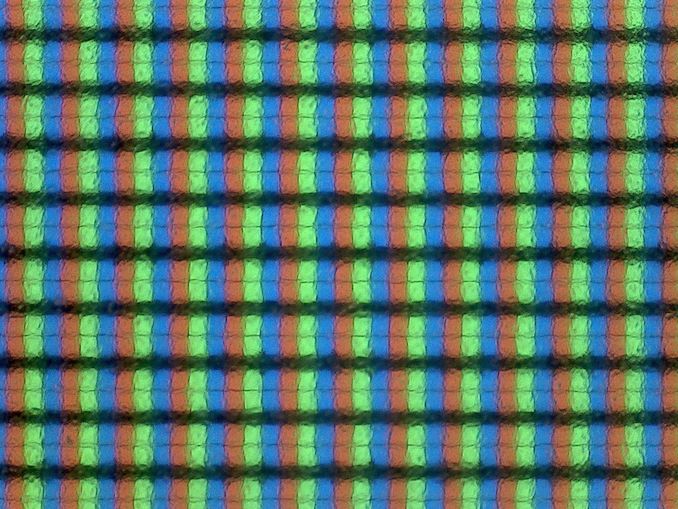 Acer Nitro 5 Subpixels with Anti-Glare coating
Acer Nitro 5 Subpixels with Anti-Glare coating
At 15.6-inches in size, the 1920x1080 resolution does allow you to run 100% scaling without the elements getting too small. That’s a benefit for sure, since you won’t get the artifacts that can still existing when using scaling in Windows 10. There’s been a lot of improvements to the OS to correct this, but not all applications have taken the time to ever deal with it. Luckily that won’t be a concern at 100%.
To test the display we use SpectraCal’s CalMAN suite with a custom workflow. Brightness and contrast readings are taken with the X-Rite i1Display Pro colorimeter, and color readings are taken with the X-Rite i1Pro2 spectrophotometer.
Brightness and Contrast
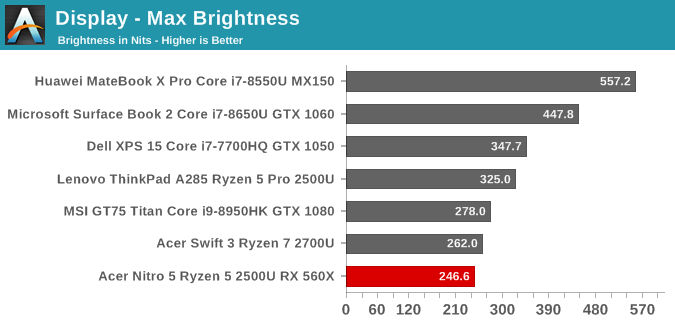
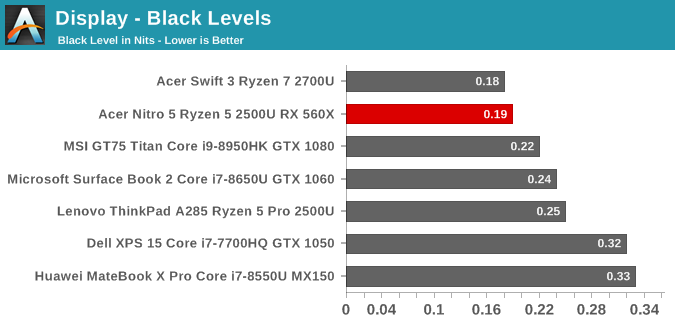
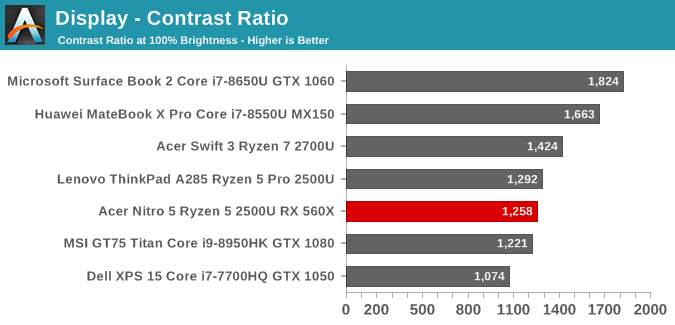
The panel on the Nitro 5 doesn’t get particularly bright, topping out at just 246 nits. It also doesn’t get particularly dark either, with a minimum brightness of 16 nits. But both values are likely fine for use indoors on a desk. The black levels are quite good though, leading to a solid contrast ratio of 1258:1 at maximum brightness.
Grayscale
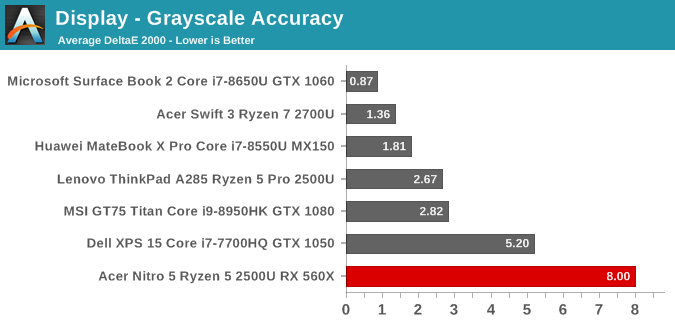
Here is where things start to get unravelled for the Nitro 5. The grayscale accuracy is terrible, thanks to the green part of the backlight being far too bright at almost any point in the range. The gamma curve is also well off the 2.2 value expected, falling increasingly under that point starting at around 35% brightness. This means there will be less of a dynamic range between highs and lows as you go towards greater brightness levels.
Gamut
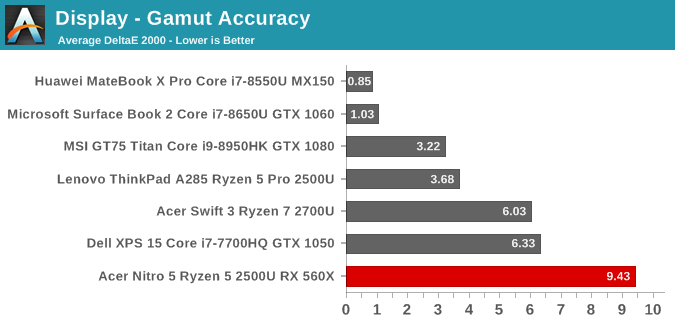
Here we can start to see the problems inherent in this display. The greens are the only colors even close to hitting the sRGB gamut, with red well under and blue doing its best impression of Hawaii. The graph ranges had to be adjusted just to see on the chart how far blue is off the mark, and at almost a dE2000 of 25, it is very, very far from where it should be.
Saturation
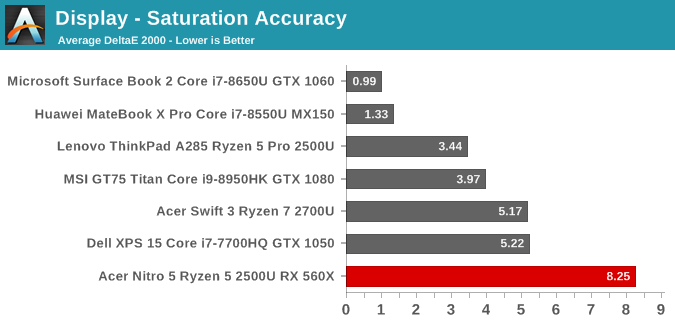
Gamut is the primary and secondary colors at 100% brightness, whereas with the saturation sweep we test with 4-bit steps from 0% to 100%. It’s amazing just how far off the blue levels are, and coupled with the less than amazing reds, the magenta values are also dramatically impacted.
Gretag Macbeth
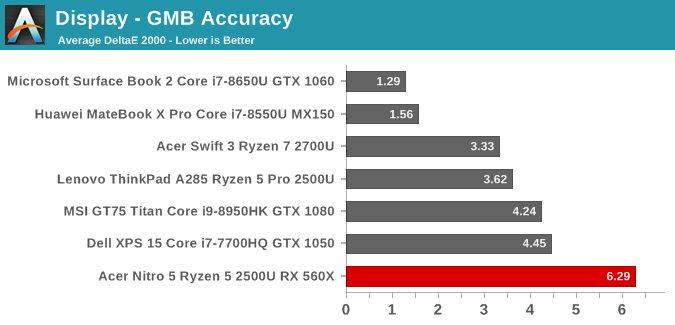
This graph also needed to have almost all of the charts adjusted to show just how far off the mark the colors are on this display. Considering the less than amazing primary colors, it’s no shock that every single color is pretty much terrible.
Colorchecker
This image shows the intended color on the bottom, and the achieved color on the top, so it gives a nice representation of the previous tests. The whites are very green, and the colors are mostly terrible.
Display Conclusion
This display is possibly the least accurate IPS panel we have ever tested. The uncalibrated panel is coupled with a backlight that can’t even come close to covering the entire sRGB spectrum. The Acer Nitro 5 is an entry-level device, and the display is one of the ways they made it to their target price.















90 Comments
View All Comments
PeachNCream - Friday, February 15, 2019 - link
The 1060's showing inside the Surface Book makes it painfully obvious that Microsoft's cooling solution suffers from some pretty severe limitations. Granted, MS wasn't trying to make a gaming system, but something thin and light to compete in more or less the same category where Apple's laptops live so cooling is going to end up taking a backseat.Brett Howse - Friday, February 15, 2019 - link
The Surface Book 2 is a 15W CPU and the XPS 15 is a 45W CPU, so in games that are CPU limited, the 1050 can outperform. Dota is a great example of this.29a - Friday, February 15, 2019 - link
I would like to see benchmarks with a second piece of RAM also.Quad_Tube - Friday, February 15, 2019 - link
I was also scratching my head when I saw it only had one-stick, albeit 8 GB capacity. Looking forward to seeing how it runs with two sticks (I think the difference would be huge).kpb321 - Friday, February 15, 2019 - link
If they were actually using the integrated GPU it would be a huge issue as the integrated GPU is often very memory bandwidth starved but as the article mentions the single stick isn't really a big problem when you are running with a discrete gpu.GreenReaper - Monday, February 18, 2019 - link
It might potentially use more power and so run slower or louder, and for less time. Laptops are a trade-off. As others have mentioned the bandwidth isn't *as* much of an issue with a discrete GPU.Alexvrb - Friday, February 15, 2019 - link
That doesn't apply to APUs when you're not even using the integrated graphics. Further, since it's a single CCX, RAM clocks don't even matter. Performance would barely budge if they were running 4 x 2. Margin of error difference.Rookierookie - Friday, February 15, 2019 - link
The screen hinge design for these laptops from Acer has not changed in a while, and anecdotally it's pretty shoddy, prone to splitting open after a couple of years.Annnonymmous - Friday, February 15, 2019 - link
I own this laptop. The screen hinge is just fine.TheinsanegamerN - Sunday, February 17, 2019 - link
Are you from the future? Otherwise, how would you know if your hings will be fine after several years of operation.